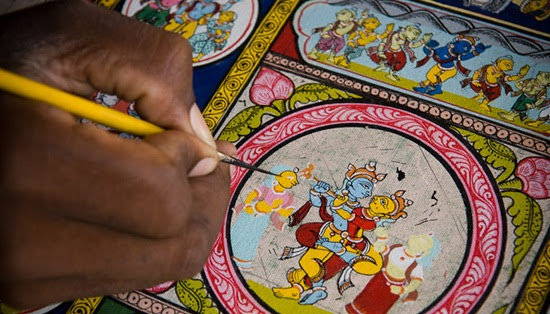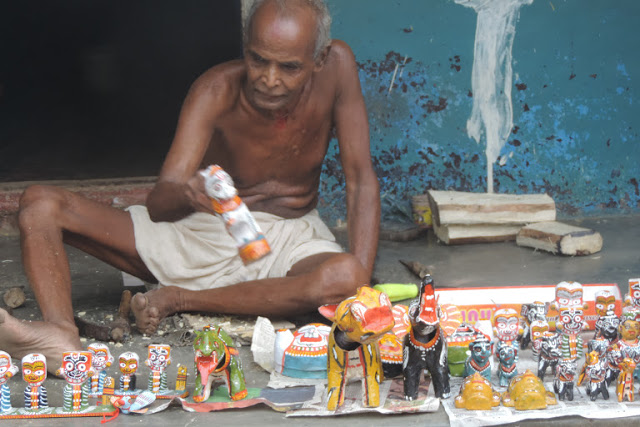To touch art is to touch a mind; to touch the mind, is to touch a life.

With its pious pilgrims, quiet hill stations, plush wilderness, less-frequented beaches and tribal charm, Odisha is truly an unmissable destination. Hemmed by the Bay of Bengal on the east, flaunting a generous coastline, this east Indian state humours the curiosity of a traveller who is eager to learn about the many strokes that paint its canvas. Home to one of the four sacred Hindu pilgrimages, Odisha is also a well-known destination for art connoisseurs and for anyone who takes delight in understanding culture and traditions.
We often hear people debating about fast fading art and handicraft heritages across the world and how that is indeed inevitable. Thankfully, as Indians, we still have some room to gush about how we have somehow managed to preserve quite a bit of our art and handicraft legacy. Raghurajpur, in Odisha can be titled as the kingpin, where special initiatives were undertaken to revive the art and heritage. Situated amidst the lush greens and adorned by coconut trees, betel vine gardens, fruit orchards and tropical plantation, this quaint village is an excellent combination of diversified nature and rich cultural heritage. Also known as the Artist’s Village, Raghurajpur was chosen to be developed, in the year 2000, as the state’s first ever Heritage and Crafts village by INTACH (The Indian National Trust for Art and Cultural Heritage).

This picturesque village ends even before it starts. You walk into a narrow lane through a rather chaste gateway – without an emphatic name slate, fancy ornamentation along the walls or any unnecessary extravaganza; just a simple, somewhat wrecked gate.At first sight, it does not serve any looks of being such a crucial breakthrough in the world of art and handicraft preservation in India. Walking through that weather-beaten entrance into this awe-inspiring hamlet does not prepare you for what lies beyond.
The lush little settlement is the keeper of an ancient bequest. It is home to the skilled artists residing in over 120 houses lined gracefully along the length of the main street. Each family is dedicated to the making of their traditional handicraft, made entirely from indigenous materials sourced from the surrounding coconut, palm and jackfruit groves on the banks of River Bhargavi. The show-stopper of course is the Pattachitra painting.

The word ‘pattachitra’ originated from the oriya words, ‘pata’ which means cloth and ‘chitra’ which means painting. Therefore, it literally means ‘A cloth painting’ which is what it essentially is. To begin with, the canvas or pata is prepared by binding two layers of cotton with a gum made of conch shell and tamarind seeds powder. Once dry, the surface of the canvas is polished with a stone until a smooth base for the painting is formed. Vibrant colours are used in delicate lines to depict stories from the Hindu mythology such as the Ramayana and Mahabharata, colourful and intricate pictures of various Gods and Goddesses, with ornamentation of flowers, trees and animals.
The aftermath is a beautiful storytelling canvas. Most of the artists use natural pigments such as white from conch shells, black from lamp black and burned coconut shell, and yellow from turmeric powder.

The talapatrachitra, or palm-leaf engraving, is another traditional craft that draws art enthusiasts to this village. It is a beautiful foldable scroll. I personally liked this one better than the colourful pattachitra. I also happened to splurge a lot on these ones in particular. It is equally strenuous to curate this painting. The yellow-green leaves are stuck together to form strips that are then sewn together with thread. The artist uses an iron stylus to etch scenes from the epics between the veins of the leaves, and may fill in the grooves with lamp black or another pigment. It takes a skillful hand to ensure the leaf doesn’t crack.

Raghurajpur, also known to be the birthplace of one of the finest Odissi exponents and Guru, Kelucharan Mohapatra, however, is not just restricted to fine art. The village also nurtures its invaluable heritage of the classical Gotipua dance form. I was also lucky to witness a graceful dance performance of the Gotipua Nritya rendered by a group of young and talented kids in their local community hall. I got totally immersed and could not help myself from getting completely engrossed with the rhythmic beating steps of the dance pouring into the twilight sky. The village at that time was filled with ecstatic chords and a whole lot of energy. I also embarrassed myself trying to shake a leg with the young professionals. Overall, it was an experience I will cherish forever.

Apart from the art and dance, another striking feature about this scenic, yet rustic settlement, was it’s architecture. The unusually high plinths seemed to stand out.
Being the curious cat that I am, for the lack of a better word, I indulged myself in a conversation with one of the eldest members of the family I had just bought a Pattachitra from, and to my surprise, he was quite willing to share their story.

In the year 2008, Odisha was hit by a severe tropical storm. The heavy monsoon rain continued to fall in the wake of this storm, taxing rivers throughout the state. The Mahanadi River breached its banks at several places, flooding more than 1000 villages across the state. Unfortunately, the village of Raghurajpur suffered a terrible hit. The entire village was swept by the storm with water upto 8 feet running over the village roads. There was a time after this, when at one point, these artists were forced to give up their art to get into agriculture for fending livelihood. But the artists did not give up. They believed in their art and their heritage. The village underwent re-development and was soon restored.
Shaken by the catastrophe and keeping in mind the possibility of history repeating itself in the future, the houses in the settlement were restored on higher plinths with a more spacious verandah than usual, to safeguard the residents to a certain extent during a possible outbreak in the future.
And today, these high plinths and lively verandahs have become the architectural identity of the village. Yes, the beautiful mural paintings on the facades of these houses facing the street is a sight for sore eyes and they do give a vibrant character to the settlement. This, however, does not contribute to the lively atmosphere in the village. The purpose of Architecture is to improve human life. Create timeless, free and joyous spaces for all activities in life. The infinite variety of these spaces can be as varied as life itself. They also must be as sensible as nature in evolving from a main idea and flowering into a beautiful entity. The overriding essence is found in the intangibles.Thus, what was built then as a mere safety precaution, has today become the heart and soul of this village. The verandah has transformed into an informal workspace for these artists where they can extend their imagination beyond the walls of their house, get inspired by nature and paint their bare canvas. The height of the plinth is such that any person walking along the street can easily see the piece of art or even observe the artist as he paints his heart out onto his canvas, whether it’s a palm leaf, a bottle or a coconut. This has encouraged the artists to develop a more informal connection with the travellers, and that has helped them in growing their economy.

Walking down the cleanly swept, narrow lanes of Raghurajpur is a very satisfying experience. Every house is built, sharing a common wall that extends into the verandah. Each house is painted in a different colour; some painted with elaborate patterns on a plain beige wall, while some decorated with minimalistic designs against a blushing pink wash. I imagined that it was every family’s expression of their personality including a sneak peek into their individuality. Nearly all the homes have open doors throughout the day and the streets are humming with kids and cattle flocking around while the artists sit cross-legged on floor mats in their verandah, working on a piece of art. Some practice painting delicate lines on pata, while others engrave folklore onto palm leaves. A few artists make miniatures of Lord Jagannath, Odisha’s most prominent deity, using coconuts and betel nuts. And finally, at sunset, I watched the women blow the conch shell with its melody resonating with the sound of the homebound birds chirping away in delight, the whistling palms swaying to the beat and the rather off-key rumblings of bullock carts as farmers returned home from work. The young girls lit tiny lamps under their family holy basil bushes in the verandah as the artists of Raghurajpur continued working on their ancient art forms, without batting an eyelid.
Truly, The Artist’s Village!
Leave a comment